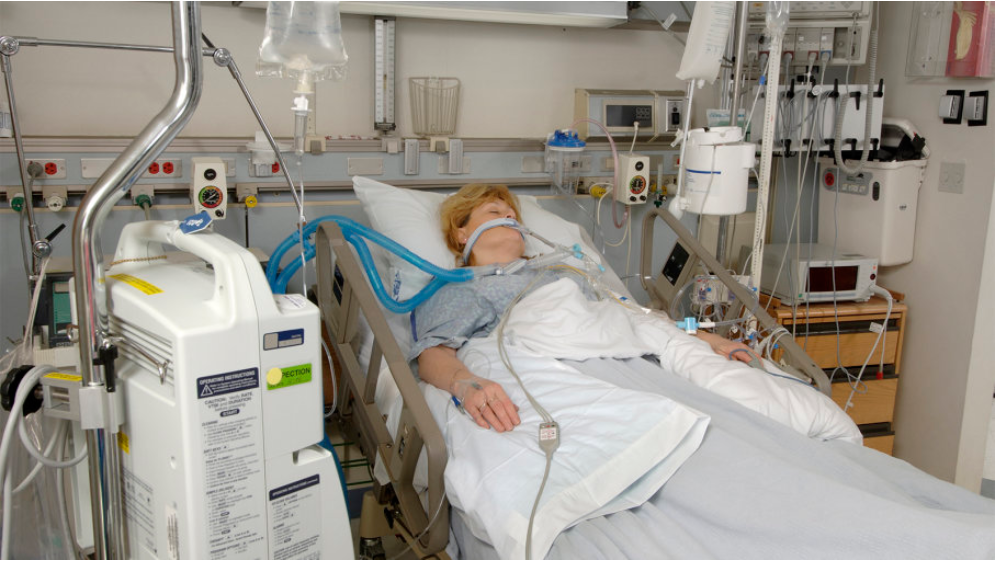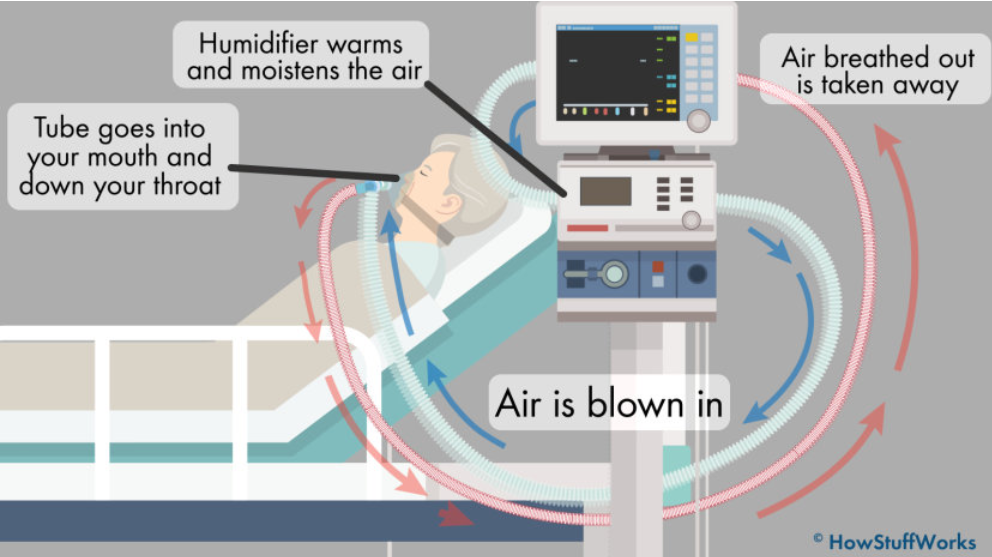呼吸机是如何工作的?为什么在新冠治疗中如此重要?
How Do Ventilators Work? Why Are They So Critical for the COVID-19 Pandemic?
BY PATRICK J. KIGER
 *The COVID-19 pandemic has created a public laser focus on a piece of medical equipment most of us probably haven't given much thought to before.
*The COVID-19 pandemic has created a public laser focus on a piece of medical equipment most of us probably haven't given much thought to before.
As the U.S. and the rest of the world scramble desperately to cope with the COVID-19 pandemic, hospitals are faced with a critical shortage of ventilators, the bedside devices that help patients who have difficulty breathing on their own.
U.S. hospitals have about 160,000 ventilators, with another 12,700 available from the federal government's National Strategic Stockpile, the New York Times reported March 18, 2020. But it's feared that will be nowhere near enough to cope with all the people who could become seriously ill from the virus.
All this has suddenly focused attention on a piece of medical equipment that most of us probably haven't given much thought to, any more than we think about breathing itself. But for someone who can't get air into his or her lungs, the device — which ranges in price from $25,000 to $50,000, according to the Washington Post — can be a lifesaver.
How Do Ventilators Work?
Ventilators assist patients with a number of different conditions. "They can be used to help people breath during routine surgery under anesthesia or also when patients are sick and have difficulty breathing due to their illness," explains Dr. Paul F. Currier, director of the Respiratory Acute Care Unit for the Division of Pulmonary and Critical Care at Massachusetts General Hospital, via email. A small proportion of people who become infected with COVID-19 may develop inflammation in their lungs. "An even smaller proportion of these patients can develop respiratory failure which is best treated with a ventilator."
"Think of the lungs as an elastic balloon," Kenneth Lutchen, dean of the College of Engineering and a professor of biomedical engineering at Boston University (BU), says via email. "You can expand the balloon by having the pressure at the opening (mouth) be greater than the pressure on the other side of it. Normally we breath by having our muscles expand the chest which lowers the pressure around the lungs inside the body so that the lungs expand.
"But if the lungs fill up with fluid or become highly inflamed — both of which can happen in coronavirus — then the negative pressures that occur with normal breathing are not sufficient to expand the lungs enough and insufficient O2 and CO2 exchange will result," Lutchen continues. "The alternative is then to 'push' air into the lungs using a ventilator which creates a positive pressure at the mouth — the inlet to the intubation tube — large enough to push enough fresh air in and out each breath. Hopefully, this can keep the blood O2 and CO2 levels close to normal until the inflammation and fluid buildup subsides and the person can breathe on their own again."
The boxy mechanical device with a digital display on the top typically sits on a cart next to the bed. As the National Heart, Lung and Blood Institute website explains, the patient is connected to the device by a breathing tube that's inserted through his or her nose or mouth down the throat, which is held in place by tape or a strap that fits around the head. The tube in the airway can cause some discomfort, and also affects a patient's ability to talk or eat. That's why the care team may insert another tube into a vein to feed the patient nutrients, or — if the person is going to be on a ventilator for a long time — insert a nasogastric feeding tube that goes directly into the stomach or small intestine through a surgically created opening.
 This diagram depicts the basic design and function of a respiratory ventilator.
This diagram depicts the basic design and function of a respiratory ventilator.
Having a tube down your throat isn't exactly pleasant, but it's important. "Without intubation several things can threaten the ability of the ventilator to do its job," Lutchen explains. "Perhaps the most important is that if the ventilator just blew into the mouth the delivered volume may not all go into the lung. Some of it could leak out the nose — which is connected to the mouth — or some can end up expanding the cheeks of the person rather than going into the lung."
The Role of the Respiratory Therapist
To get this all to work, hospitals depend upon the expertise of highly trained professionals called respiratory therapists. "The respiratory therapist determines the appropriate settings to match the patient's respiratory needs based on the underlying disease condition," explains Timothy R. Myers, a respiratory therapist and chief business officer of the American Association for Respiratory Care, by email. "From that point, they provide constant monitoring and assessment and modify the setting as the patient's condition improves or worsens. This would include noninvasive monitoring and measurements from blood analysis to look at oxygen and carbon dioxide levels."
This requires a lot of careful management, because lungs are pretty complicated, Myers explains. While it's useful to think of the lungs as a balloon for illustrative purposes, in reality, they're "more like a network of millions of balloons that must transfer gases between the lungs and the circulatory system. When the lungs are damaged or diseased, each lung and the millions of balloons require gas entry in and out differently than when healthy. Each patient is unique."
In recent years, there have been some advances in how ventilators are used. "Research has shown that using low breath size and low pressures improves outcomes," Currier explains. "Also, patients with severe respiratory failure may at times be turned on their stomachs while on the ventilator, a process called prone positioning, which can often improve their oxygen levels. Finally, for some patients whose oxygen levels remain low despite being on a ventilator, they may be able to receive Extra-Corporeal Membranous Oxygenation (ECMO) in some very specialized centers. This highly intensive therapy can circulate the blood outside of the body to provide additional oxygen."
Lutchen's research focuses upon developing safer mechanical ventilators. "Initially the ventilator is working to save a life by keeping proper O2 and CO2 levels," he says. "But it does this by pushing air in and exposing the lung to abnormal pressures, often larger pressures to help expand a stiffer and/or narrower lung. Also a ventilator is programmed to give the exact same breath every time where normal breathing varies a little from breath to breath and we periodically take a big breath. If you need to be on a ventilator for a very long time there is a risk of the repetitive large pressures to cause Ventilator Induced Lung Injury (VILI) which could facilitate Acute Respiratory Distress Syndrome (ARDS). Now the ventilator may no longer be able to provide enough O2 and CO2 exchange."
That's why Lutchen is working with lead investigator Bela Suki, a professor of biomedical engineering at BU, on a concept called variable ventilation, in which the ventilator delivers variable breaths similar to a natural breathing pattern, to avoid repetitive abnormal pressures in the same location when a person breathes. "There is some evidence in animals that this approach is less likely to lead to VILI and can facilitate recovery from ARDS," Lutchen says. "But the approach has not yet been tested in humans."
The Current Rampup
With the current shortage of ventilators, manufacturers are ramping up production. Medtronic, one of the world's major ventilator makers, is gearing up to double its output, by adding shifts to keep its Irish manufacturing plant running around the clock, a Medtronic company representative wrote to HowStuffWorks.
But manufacturers face a challenge in increasing production, because ventilators must be built with great care. "As these are live-saving devices, very high standard in terms of quality assurance apply," Swiss-based manufacturer Hamilton Medical AG says via email.
NOW THAT'S INTERESTING
Though modern ventilators have been around only since the 1950s, the concept of mechanically providing air to a patient by inserting a tube was first described by Andreas Vesalius, a Belgian who was a professor at the University of Padua, back in 1543, according to this article on the history of ventilation by Arthur S. Slutsky in the American Journal of Respiratory and Critical Care Medicine.